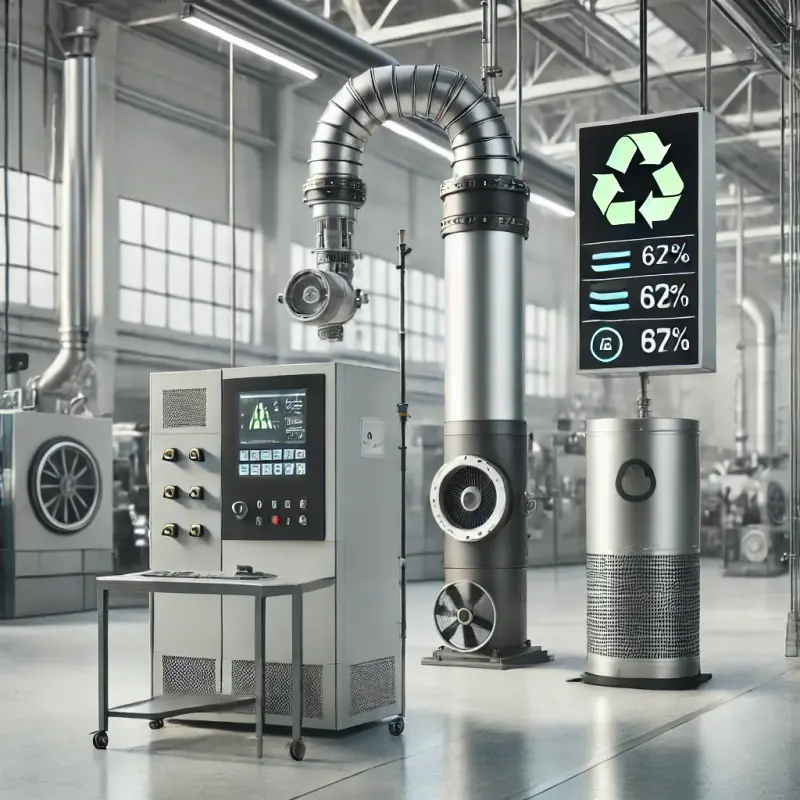Eco-Technologies for Emission Reduction in Manufacturing: How Devices Minimize Environmental Impact

As the world turns toward sustainability, the manufacturing industry is increasingly adopting eco-technologies designed to curb emissions and reduce environmental harm. From pollution control devices to energy-efficient equipment, these innovations are transforming industrial processes to become greener and more resource-efficient. This article delves into the key eco-technologies that aid in reducing emissions, the devices behind these advancements, and their growing impact on sustainable manufacturing.
The Rise of Eco-Technologies in Manufacturing
Historically, manufacturing has been one of the leading contributors to greenhouse gas emissions, as well as other pollutants that affect air, water, and soil quality. However, with the urgent need to address climate change, there has been a shift towards integrating green technology into production processes. These eco-technologies are not only aimed at reducing harmful emissions but also optimizing energy and resource use, thus promoting a sustainable approach to production.
Key Eco-Technologies for Emission Reduction
The following eco-technologies play a vital role in emission control across various types of manufacturing:
-
Emission Capture and Filtration Systems: These systems are designed to capture pollutants directly at their source. Technologies such as electrostatic precipitators, fabric filters, and carbon absorption systems help to trap particles and reduce airborne emissions. They filter and contain toxic particles before they reach the atmosphere, minimizing air pollution significantly.
-
Waste Heat Recovery Systems: These systems are used to capture and repurpose the heat produced during manufacturing. Instead of allowing excess heat to escape, waste heat recovery units channel it back into the production cycle. This reuse reduces the need for additional energy sources, thus lowering the carbon footprint of manufacturing facilities.
-
Water Purification and Recycling: Modern water purification and recycling technologies help reduce water waste and prevent toxic discharge into natural waterways. By using reverse osmosis and filtration, manufacturers can purify and reuse water within the factory, limiting water pollution and reducing the environmental footprint.
-
Energy-Efficient Machinery and Devices: Today’s machinery is often powered by energy-efficient devices that use advanced motors and optimized power systems. Energy-efficient compressors, pumps, and other industrial equipment reduce overall energy consumption, which in turn helps reduce emissions.
-
Carbon Capture and Storage (CCS): One of the most advanced and effective technologies, CCS captures carbon dioxide emissions produced from industrial processes and stores them underground. This technology is particularly useful in industries that produce high levels of CO₂, such as cement, steel, and chemical manufacturing.
How Devices Minimize Environmental Impact in Manufacturing
Specific devices have become indispensable in minimizing the ecological footprint of industrial operations. These devices are often designed to work with existing equipment or as part of advanced systems integrated directly into production lines.
-
IoT-Enabled Monitoring Sensors: Internet of Things (IoT) devices are widely used to monitor energy use, emissions, and waste levels in real time. These sensors gather data continuously, allowing facility managers to track key environmental indicators and make quick adjustments to processes to minimize waste and emissions.
-
Electric and Hybrid-Powered Equipment: Traditional manufacturing equipment often runs on fossil fuels, which can be a major source of emissions. The adoption of electric and hybrid-powered machinery has significantly reduced reliance on fossil fuels, thus lowering greenhouse gas emissions across various manufacturing sectors.
-
Advanced Air Filtration Devices: Devices equipped with high-efficiency particulate air (HEPA) filters, along with UV disinfection, have become essential in keeping pollutants from entering the atmosphere. These filters capture microscopic particles and prevent them from being released, effectively controlling the quality of air discharged from factories.
-
Smart Energy Management Systems (EMS): These systems use real-time data to optimize energy consumption in manufacturing facilities. EMS devices help control lighting, heating, and machinery operations based on need, reducing unnecessary energy consumption and lowering emissions.
-
Renewable Energy Devices: Many factories have adopted solar panels, wind turbines, and other renewable energy devices to offset their dependence on fossil fuels. These renewable installations contribute to a greener production process and reduce the carbon footprint of industrial facilities.
Examples of Sustainable Manufacturing in Action
Several manufacturing companies are already implementing these eco-technologies to achieve significant reductions in emissions:
- Automobile Industry: Many car manufacturers now use energy-efficient assembly lines and are transitioning to electric-powered equipment. They also use IoT sensors to monitor and reduce emissions from production processes.
- Textile Manufacturing: Factories in the textile sector have adopted water recycling systems and low-energy dyeing processes. This reduces both water waste and pollution from dyes, which can be harmful to local ecosystems.
- Food and Beverage Industry: By installing heat recovery units, the food and beverage industry can reuse waste heat in production, lowering energy needs. Many companies are also transitioning to biodegradable packaging to further reduce their environmental impact.
The Future of Eco-Technologies in Manufacturing
As green technology continues to advance, the manufacturing industry is set to embrace more sophisticated methods of emission reduction and energy conservation. Future trends likely include:
- Carbon-Neutral Facilities: With advancements in carbon capture and renewable energy, some manufacturing plants are aiming to become entirely carbon-neutral. This would mean all emissions are offset by eco-technologies, making these facilities more sustainable.
- Circular Economy Integration: Manufacturers are increasingly looking at ways to close the loop on resource use. By recycling and reusing materials, factories can reduce the need for new resources, limiting waste and lowering overall emissions.
- Automation and AI for Efficiency: The integration of artificial intelligence and robotics in production processes helps optimize energy use and minimize waste. These technologies adjust processes in real time, ensuring the most efficient use of resources and the least possible emissions.
By adopting eco-technologies, manufacturing facilities are not only complying with environmental regulations but are also moving toward a sustainable future. These technologies demonstrate how innovation can help industry reduce its environmental impact, benefitting not just the companies themselves but also the planet as a whole.
Articles
Subscribe to our notifications to receive the latest and most interesting articles directly in your inbox.